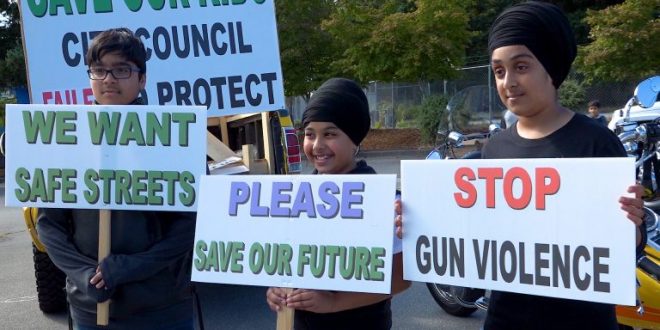A part of Sikh culture has transformed from promoting social justice to a culture passion ate about violence and greed
By Balraj S. Kahlon
Battles fought by Sikh Gurus were not against any communalism and orthodoxy but they fought for the betterment of society, to protect people from tyranny and for the upliftment of their souls.
- Max Arthur Macauliffe (1841- 1913), British Scholar
This was the legacy gifted to Sikhs; but sadly, today many bring down the reputation of the Sikh community. The recent death of two teens in a targeted shooting has shaken the community and led to a gathering of thousands at the Wake-Up Surrey rally. The Rally has called for action on the most serious issue which is youth involvement in gang violence and the drug trade. To understand this issue requires a critical look at the mindset that exists within the Punjabi Sikh culture.
Many Punjabi drug dealers came through my high school. Many young guys would talk about them with admiration as if they were freedom fighters. Not realizing these dealers would likely kill them if it would make them a profit. The high school did have the reputation of being a bad school and many boys were proud of this reputation and worked to keep it. Fights were a part of school and seemed to happen monthly. Often guys would go after someone like a pack of dogs. The worst is when they would pick on girls. The reasons for the fights were always meaningless. All that mattered was looking tough.
This problem is not limited to the Canadian born. Guru Nanak’s Free Kitchen once organized an information session for international students from India. A police officer spoke at the event to caution the students about the drug trade. When the officer asked if they knew anything about the local drug trade many students raised their hands and started shouting BindyJohal, Punjabi Mafia, etc… We all laughed but it is sad that these young men probably know more about Punjabi criminals in Canada than the GhadarParty in Canada. At the end another student asked if international students can get a gun in Canada. Another reminder of how important it is for Punjabi Sikh men to look dangerous.
The penchant for bravado and violence is also not limited to youth. Hostile political rivalries to control Gurdwaras in the local Sikh community are well known. The most infamous case, and height of shame, was in 1998 at Ross Gurdwara where men were spilling blood and fighting in the langar hall. As a result, to this day, there is police presence at gurdwara elections as if Sikhs need a babysitter. In fact, there are numerous YouTube videos of gurdwara fights from around the world. Even some parts of the Surrey Nagar Kirtan depict violent images.
My cousin once commented he has seen the same penchant for violence growing up in Punjab. “It’s just in our blood” he said. But is this what we have become? Sikhs have gone from a history of fighting against oppression to many acting like oppressors.
In my adult life I have also become aware of another damaging trait among many Punjabi Sikhs: the desire for easy money. We all want nice things but I find many treat honest work as a sin. In college, I knew of young Punjabis dipping into the drug trade for easy money. These were young men from prosperous families.
And again there are enough examples to show this problem is not limited to the young. In 2005, a member of the Sikh community, and, former MLA candidate, was caught smuggling drugs across the US border. News articles have raised concern about Indo-Canadian truck drivers involved in the drug trade. In Surrey, there are grocery stores selling dode (an addictive opium-based substance) under the table. In fact, this is happening in Sikh communities across Canada. The sad truth is within the community we have a reputation of putting money before morals.
It is also interesting to see the parallels between here and Punjab. The same time the Wake-Up Surrey rally launched to address gang violence, Punjab had its Black Week to pressure the government to address the drug addiction crisis and crackdown on drug smuggling. Many argue if Punjab wants its youth to stop getting involved in drugs then the adults should stop bringing drugs into Punjab. I think the same argument applies here.
Furthermore, the problem of organized gangs involved in drug trafficking is common in many Sikh communities. In a 2002 news article Wally Oppal asked: “Why has the Indo-Canadian community raised a disproportionate number of killers?” In England, a 2006 Birmingham Post article discussed the lack of cooperation from the Sikh community to help police fight gangs within the community. In California, a 2008 Mercury News article discussed the difficulty in explaining why gangs in Alameda and Santa Clara County are predominately Sikh.
Finally, Punjab, the only Sikh majority region in the world has become the drug capital of India. Even more, it is reported that political candidates try to attract votes by offering free drugs and alcohol.The fact is drugs (including alcohol), to get high and make a profit, are a growing part of the Punjabi Sikh culture.
Some may feel this article negatively portrays the Sikh community. I acknowledge there are many more Sikhs doing good work than bad. However, the purpose of this article is not to describe the entire Sikh community but to describe the cancer that exists within. Many sikhs have gone from a history of people passionate about social justice to a current culture passionate aboutviolence and greed. The inability to address this cancer has only helped it grow. The people who choose to be silent are taking the side of those involved in drugs and violence.
However, the Walk-Up Surrey rally has led to community actionto address gang violence and the attraction of drugs in the community. Admittedly,this is a complicated issue with no quick or easy answer. A start is for everyoneto think about what our culture tells people to value compared to what we want our children to value.In my life, I havelearned to have greatadmiration for the person making an honest living mopping floors to support their family, not the person with an expensive car or big house.
For years I have been volunteering in the Vancouver Downtown Eastside with Guru Nanak’s Free Kitchen and have seen the damage and pain caused by the drug trade. If the Sikh community wants to keep its children safe then they must be on the side fighting to stop this pain, not profiting off it.
(Balraj S. Kahlon has a Master degree in Public Policy and has been an active volunteer in the community for several years)
(Disclaimer: The views expressed in the article are that of the author and do not necessarily reflect viewpoint of the publishers)
 Desi Today Magazine
Desi Today Magazine




